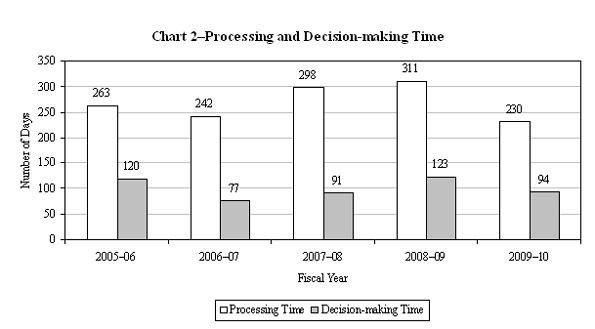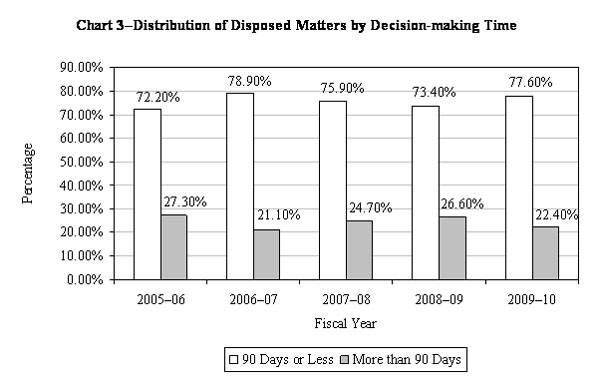Common menu bar links
Breadcrumb Trail
ARCHIVED - Canada Industrial Relations Board - Report
 This page has been archived.
This page has been archived.
Archived Content
Information identified as archived on the Web is for reference, research or recordkeeping purposes. It has not been altered or updated after the date of archiving. Web pages that are archived on the Web are not subject to the Government of Canada Web Standards. As per the Communications Policy of the Government of Canada, you can request alternate formats on the "Contact Us" page.
SECTION II: ANALYSIS OF PROGRAM ACTIVITY BY STRATEGIC OUTCOME
Strategic Outcome
Resolution of Labour Relations Issues in Sectors Regulated by the Canada Labour Code in a Timely, Fair and Consistent Manner
When the Board receives an application or complaint, it is usually because there is some form of unresolved conflict or problem in the workplace that the parties involved have been incapable of resolving on their own. Through mediation or by issuing a decision, the Board effectively and directly contributes to its sole strategic outcome namely, the resolution of labour relations issues. The impact of the work of the Board can be both broad-ranging and significant. The Board's decisions and mediation efforts often affect, in very tangible ways, the working lives of thousands of Canadians, the economic position of leading Canadian corporations, and the general well-being of the Canadian public.
The Board also contributes, in an indirect but no less important manner, to effective industrial relations in the federal jurisdiction. Each time it issues a decision, the Board adds to its growing jurisprudence, which is widely disseminated to the industrial relations community. Clear and consistent jurisprudence provides an environment where potential litigants are more likely to resolve matters on their own, rather than to bring the matter before the Board. It is, however, difficult to ascribe a quantitative measure to this contribution to the labour-management relationship.
Program Activities by Strategic Outcome
The CIRB has only one key operational program activity—the Adjudicative and Dispute Resolution Program. Through this program, the CIRB resolves labour relations issues by exercising its statutory powers relating to the application and interpretation of Part I (Industrial Relations), and certain provisions of Part II (Occupational Health and Safety), of the Code. Activities include the granting, modification and termination of bargaining rights; the investigation, mediation and adjudication of complaints alleging violation of Part I of the Code; the determination of levels of services required to be maintained during a work stoppage; the exercise of ancillary remedial authority; the exercise of cease and desist powers in cases of unlawful strikes or lockouts; the settlement of the terms of a first collective agreement; and the provision of administrative services to support these activities.
The second activity of the Board, which would not exist without the first, is to provide the internal support required to carry out the Board's primary program. It consists of the groups of activities and resources that are administered to support the operational needs of the Board's Adjudicative and Dispute Resolution Program and other corporate obligations of the CIRB, including Central Agency requirements. These groups are: management and oversight services; human resources services; financial and administrative services (including facilities, materiel and procurement services); information management services; and information technology services.
Information on both activities is provided in the tables below.
| 2009–10 Financial Resources ($ thousands) |
2009–10 Human Resources (FTEs) |
||||
|---|---|---|---|---|---|
| Planned Spending |
Total Authorities |
Actual Spending |
Planned | Actual | Difference |
| 9,188 | 9,774 | 9,546 | 80 | 74 | -6 |
| Expected Results |
Performance Indicators |
Targets | Performance Status |
Performance Summary |
|---|---|---|---|---|
| Labour relations issues are resolved in a timely, fair and consistent manner | Average case processing time | 50 days or less for certification applications that do not require a vote | Mostly met | Almost 60% of certification applications that do not require a vote are disposed of in 50 days or less. Average processing time for all cases declined by 25% |
| Average decision-making time | 90 days or less | Mostly met | More than 73% of matters had a decision making time of 90 days or less. Excluding DFR complaints, which are lower priority cases, the percentage increases to almost 84% | |
| Percentage of CIRB decisions upheld in Federal Court | 100% | Mostly met | Of the 20 applications heard by the Federal Court of Appeal for judicial review of Board decisions, only one of the applications was granted | |
| Percentage of applications for reconsideration of original CIRB decisions | Less than 10% | Met all | A total of 48 applications for reconsideration were received, which represents 6.9% of matters received by the Board |
| 2009–10 Financial Resources ($ thousands |
2009–10 Human Resources (FTEs) |
||||
|---|---|---|---|---|---|
| Planned Spending |
Total Authorities |
Actual Spending |
Planned | Actual | Difference |
| 3,399 | 3,992 | 3,780 | 30 | 31 | +1 |
Benefits for Canadians
The Board contributes to promoting a harmonious industrial relations climate in the federally regulated sector through the impartial, effective and appropriate administration of the rules of conduct that govern labour and management in their representational and bargaining activities. In achieving this, the Board provides effective industrial relations solutions for the Canadian labour relations community in a fair and timely manner.
The impact of the work of the Board can be both broad-ranging and significant. The Board's decisions and mediation efforts often affect, in very tangible ways, the working lives of thousands of Canadians, the economic position of leading Canadian corporations, and the general well-being of the Canadian public. When the Board receives an application or complaint, it is usually because there is some form of unresolved conflict or problem that the parties involved have been incapable of resolving on their own. By resolving the matter, through mediation or by issuing a decision, the Board effectively and directly contributes to improved labour management relations in that enterprise.
Performance Analysis
Processing Time
The average time required to process a file—the time spent opening, investigating, mediating, hearing, and deciding a case—dropped significantly in 2009–10 to 230 calendar days from 311 in 2008–09. This is the lowest average in five years (see Chart 2). Although the decline in average processing time is evident for most types of matters in 2009–10, it is largely the result of the steep reduction in the processing of DFR complaints, which stood at 269 calendar days in 2009–10 compared to 459 days to previous year, a reduction of over 40%. Prior to 2007–08, DFR complaints were often set aside when more urgent matters arose. As a result, the CIRB had accumulated a significant backlog of DFR complaints, and their proportion of all pending matters grew from 25.6% in 2002–03 to almost 43% at the end of 2006–07. The CIRB took steps to seriously address this DFR backlog starting in the last quarter of 2007–08 and more extensively in 2008–09. One consequence of this is that the average processing time rose during this period, given that many of the resolved complaints were long-standing. Nevertheless, average processing time is the lowest it has been since 2003–04.
Decision-making Time
One component of the overall processing time is the length of time required by a Board panel to prepare and issue a decision following the completion of the hearing of a matter. A panel may decide a case without a hearing on the basis of written and documentary evidence, such as investigation reports and written submissions, or may defer the decision until further evidence and argument is obtained via an oral hearing.
Similar to processing time, and for many of the same reasons, the average decision-making time of disposed matters dropped significantly in 2009–10 to 94 days from 123 days in 2008–09 (see Chart 2). Another approach to evaluating the Board's performance on decision-making time is to use section 14.2(2) of the Code as a benchmark. This section requires that a panel must render its decision and give notice of it to the parties no later than ninety days after the day on which it reserved its decision or within any further period that may be determined by the Chairperson. By this criterion, the Board also shows an improvement in 2009–10 with close to 78% of cases having a decision rendered in 90 days or less, compared to slightly more that 73% in 2008–09 (see Chart 3). Excluding DFRs, the proportion rises to about 83%.
Judicial Reviews
Another measure of the Board's performance, as well as a measure of the quality and soundness of it decisions, is the frequency of applications for judicial review of Board decisions by the Federal Court, and the percentage of decisions upheld as a result of these reviews. In this respect, the Board has performed exceptionally well. Of the 20 reviews heard by the Federal court in 2009–10, only one of the Board's decisions was not upheld, and in the last five fiscal years, only two were not upheld out of a total of 97 applications heard by the court.
Examples of significant judicial reviews in 2009–10 can be found at: http://www.cirb-ccri.gc.ca/publications/report-rapport_eng.asp.
Applications for Reconsiderations
Applications for reconsideration of Board decisions are an additional measure of the soundness and quality of Board decisions, and are also potentially an indication of future applications for judicial review to the Federal Court of Appeal. In 2009–10, the proportion of applications for reconsideration to all applications/complaints fell to 6.9% from 8.3% in 2008–09. There were 56 applications for reconsideration that were disposed in 2009–10; only two were granted.
Additional statistics can be found at: http://www.cirb-ccri.gc.ca/publications/report-rapport_eng.asp.
Internal Services
Internal services make a critical contribution to the achievement of the sole primary program. The Board is committed to continuously seek effective and efficient internal service delivery and is working to address challenges in line with the Clerk of the Privy Council's Public Service Renewal priorities. During the reporting period, the Board undertook a review of its Client and Corporate Services, taking into consideration the evolving federal government direction with respect to shared services, where appropriate. Progress has been made on the planning of mitigation strategies to alleviate skills shortages and high employee turnover.
Lessons Learned
The complexity and implications of the issues facing federally regulated employers and unions require the Board to judiciously apply a wide range of knowledge and skills in diverse industrial relations, labour law and administrative law contexts. The development of Board jurisprudence and a generally stable economic environment over most of the 2000 decade resulted in a decrease in the number of cases coming before the Board, but the current environment may well change that situation. It is possible that the Board will receive more ULP complaints as a result of difficulties at the bargaining table, as well as more applications related to corporate restructuring or sale of business.
The significant improvement in the processing of DFR complaints has shown the Board that innovative measures developed in consultation with stakeholders is both possible and effective. Over the next year or two, stakeholder consultations are expected to focus on the review of the Board Regulations, and will likely lead to the implementation of other measures that will have as great an impact on case processing and disposition.


